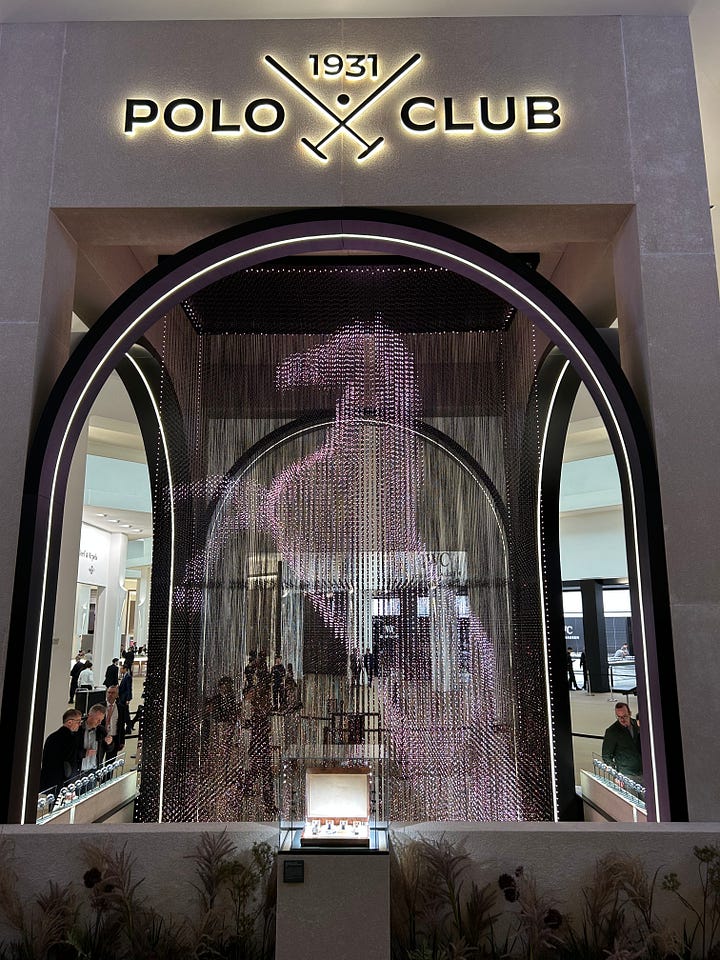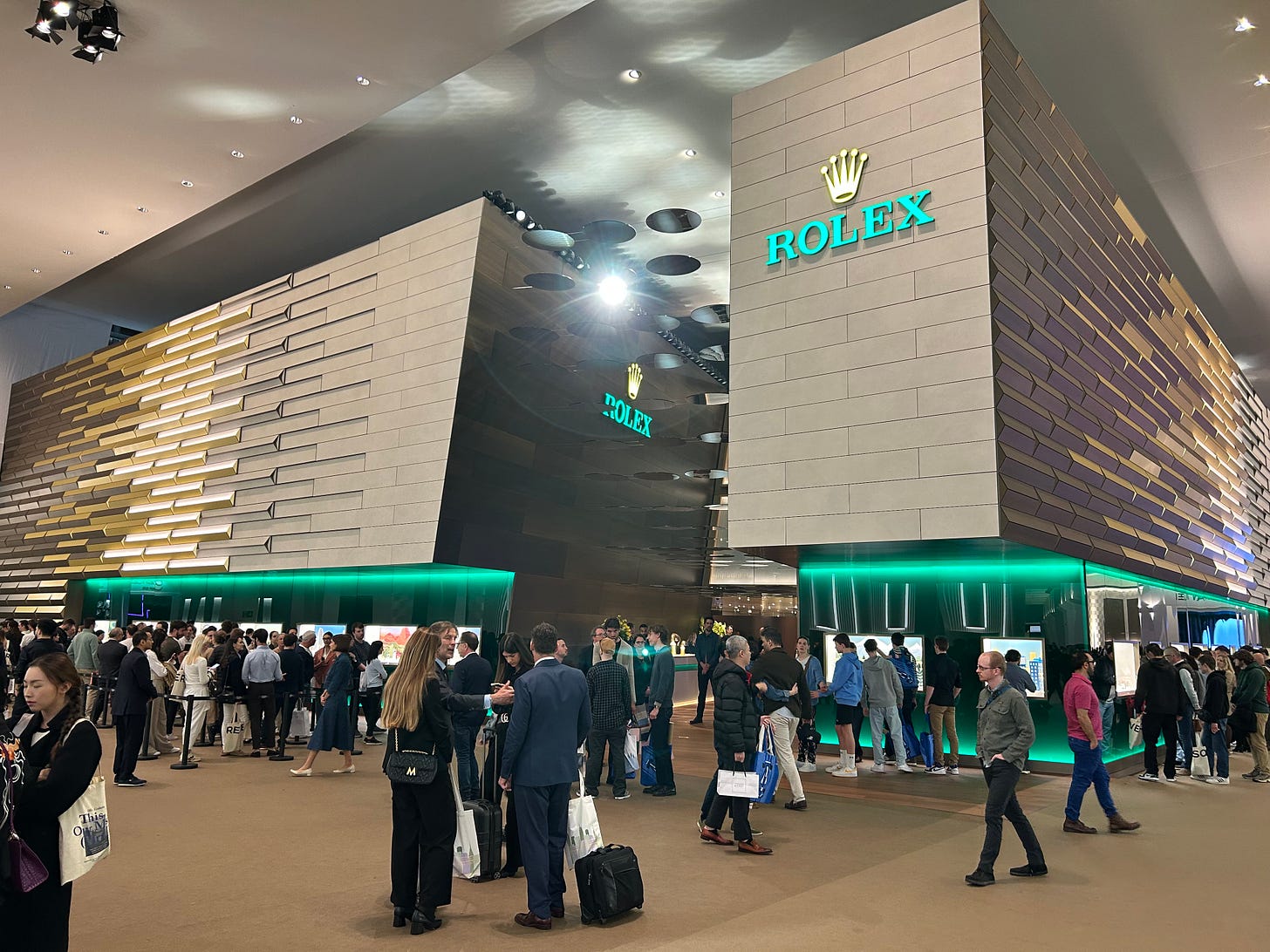Watches of Switzerland (WOSG): Insights from Watches & Wonders
Update on how tariffs may impact WOSG and Rolex margins
Watches & Wonders is the watch industry’s key trade show. Held in Geneva, Switzerland, the event brings together nearly all the major brands and 55,000 visitors.
Shortly before I arrived, President Trump announced tariffs of 31% on Switzerland. Many brands told me that although the news was a shock and responses have not been finalized, price rises are inevitable.
My biggest insights from the event are:
A 31% tariff reduces Watches of Switzerland group (“WOSG”) profits by around 15%.
Roughly speaking, an X% tariff reduces WOSG group profits by 0.5* X%. For instance, if tariffs come down to 15% then WOSG profits reduce by around 7.5%.
Rolex is not favoring Bucherer over other retailers in any material way and does not appear to have plans to.
I believe that WOSG’s stock price has overreacted to the news on tariffs. The company trades on 9x FCF for a business that should grow at low double digit rates in most years. I believe intrinsic value three years from now will likely be well over double today’s stock price.
Watches of Switzerland group (WOSG) is a retailer and partner to Rolex and other luxury watch brands. Most of the company’s value lies in its relationship with Rolex, which only sells through authorized retailers like WOSG. That makes WOSG’s economics far superior to a typical retailer and more like a subsidiary of Rolex.
Management are competent, experienced, and well incentivized, with CEO Brian Duffy owning £25mm of stock. Duffy joined in 2014 and his strategy of investing to elevate customer experiences has grown WOSG’s share of Rolex sales in the UK from around 35% to 50%. This encouraged Rolex to entrust WOSG with replicating its strategy in the US, where it is now the number one player with 10% share and has grown at 30% p.a. for the last five years.
The stock has fallen 75% since 2022 after Rolex acquired another retailer called Bucherer and the luxury watch bubble burst. Investors are concerned that WOSG’s relationship with Rolex is in danger, but our work suggests it is not and that even with tariffs the US offers a large structural opportunity for WOSG to deploy capital at 20% returns.
Subscribe now to read our 35 page Special Report based on conversations with 19 sources and 10 store visits.




Many brands had extraordinary boutiques at Watches & Wonders and did an impressive job of telling their stories, but one brand stood out far ahead of the others.
Rolex.
The trade show opened at 8.30am each day and I estimate that by 9am the Rolex boutique was surrounded by a long queue with a wait of around 30 minutes. By 10am the wait time had increased to an hour, while most boutiques still had little or no queue to enter.
In fact, the Rolex halo was so strong that even the boutique of it’s sister brand Tudor had a longer queue than any other brand.
Rolex’s boutique and exhibits themselves did not particularly stand out and were fairly limited. Almost all were focused on the new Land Dweller watches the company has released.
And while the watches are clearly impressive, I could not help but notice when touring the other boutiques that there are many other brands with watches that display a similar or even higher level of craftsmanship and technical excellence.
Why then is Rolex so dominant?
In the mind of many people Rolex is not just selling a watch, it is also selling prestige and status. I think a lot of that comes from the company’s continually brilliant marketing and partnerships over generations.
Rolex not only has the largest market share in the luxury watch market, it has an even larger share of mind.
And while some other brands can match the technical qualities of Rolex watches, that has not helped them gain market share because they have not gained share of mind.
From what I saw and heard, there is no brand that has a chance of closing the gap to Rolex in a material way. It would take decades of marketing and Rolex’s scale today allows it to invest much more in marketing than it’s competitors - meaning it’s moat is arguably widening.
This moat also resulted in a hierarchy to Watches & Wonders.
While Rolex’s boutique was the size of a building, most of this was reserved for VIPs and the public spaces were quite small. The allocation of space was reversed for most other brands. The only brand that felt more exclusive than Rolex was Patek Philippe, which had a boutique you could not even enter unless you were a VIP.
Tariff Impact on Watches of Switzerland
Nearly everyone from a non-waitlist brand told me that conditions were already difficult before the tariff news, although things were better in the US. Several non-waitlist brands even encouraged me to buy a watch on the spot.
Despite these conditions price rises sound inevitable, but no final decisions have been made as brands wait and see what the final tariff will be. Some brands had also moved more inventory into the US in anticipation of tariffs.
The head of pricing at one major brand told me they are waiting for an instruction from their parent company to co-ordinate price rises across all its brands.
Overall, my estimate is that a 31% tariff on Swiss imports reduces WOSG’s US earnings by about 31% and group earnings by about 15%. Intrinsic value should reduce by significantly less than 15% as tariffs may be reduced and/or temporary.
Here are models of the mechanics under different scenarios:





